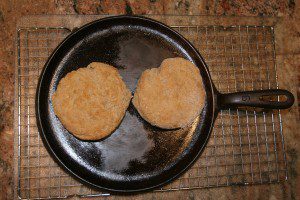Some simple flour recipes can be invaluable when bad stuff happens, you have hungry people to feed, and there aren't a lot of ingredients available.
by Leon Pantenburg
 It only took the addition of some other grains to make this basic bannock survival ration into a tasty, nutritious food. (Pantenburg photo)[/caption]
It only took the addition of some other grains to make this basic bannock survival ration into a tasty, nutritious food. (Pantenburg photo)[/caption]Bannock is the traditional bread of Canada and the Northwest. Native people had no access to wheat flour prior to the arrival of European traders, although some flour substitutes existed, like wild turnips or corn, dried and ground to a powder.
Bannock actually originated in Scotland. Because bannock could be quickly prepared from readily-available ingredients, and because these ingredients lasted a long time without spoiling, bannock became a staple of European fur traders and subsequently, the native people also.
But the original recipe is nothing but flour and water, and traditional bannock is essentially frontier junk food.
Here's how to add a few ingredients to make flour-based survival foods more nutritious.
Start by amending the flour. Basic, white, bleached all-purpose flour has virtually all the nutrients taken out of it in processing. To each cup of white flour, add one tablespoon of soy flour, a tablespoon of dried milk and a teaspoon of wheat germ. According to "Classic Sourdoughs: A Home Baker's Handbook" by Ed Wood, such an amendment combines enzymes and creates a complete protein, similar to meat.
I've used this amendment for years, and you can't taste the difference in the baked goods. Try amending the flour in all your survival recipes that use white flour, such as hardtack, and you'll feel the difference. Here is the traditional bannock recipe:
 Bannock Recipe
Bannock Recipe1 c flour
4 tsp double-acting baking powder
2 Tbs powdered skim milk
Stir ingredients together; stir in water to make dough moist. Knead dough until smooth. Place in greased cast iron skillet or Dutch oven over the campfire or on coals and bake about five to 10 minutes until the top is brown. Then turn the bread and brown the other side.
A handy way to prepare for a backpacking or hiking trip is to mix all the dry ingredients in a Ziplock bag. Just add 1/2 cup of water and knead in the bag. Then take out the dough, finish kneading and spread it in the pan.
(Practice baking the bannock by the campfire. Put the dough in a greased skillet, and place it near the campfire, propped at about a 60-degree angle with a stick. When the side nearest the fire browns, flip the bread and brown the other side. In a pinch you could bake it on a plank!)
SurvivalCommonSense Bannock Recipe
1/8 tsp salt
1 Tbs soy flour
1 tsp buckwheat flour
1 Tbs flax meal
2 Tbs stone ground whole wheat flour
4 tsp double-acting baking powder
Pace all the above ingredients in a one cup measure and add enough unbleached bread flour to make one cup of dry ingredients in volume. Add 2 Tbs powdered skim milk, and stir until thoroughly mixed.
Add enough moisture to make a moist dough, and knead until smooth. Place in a greased cast iron skillet and bake. If you're making this inside, bake at 425 degrees for about 20 minutes.
Except for the different ingredients, you can treat the improved recipe just like the traditional. Put the improved bannock mixture in a ziplock bag to make later on the trail, and you can cook it just like the traditional recipe.
With either recipe, bannock is a quick, easy way to make use of wheat flour. Both recipes are good survival tools that could prove to be really useful in your survival kit!
Here's an easy, simple recipe for grilling chicken.
(Here's a way to add some poetry and fun to your next campout: Mix up one of the above recipes and get it started cooking over the fire. Then whip out this Robert Service poem and read aloud: While the Bannock Bakes.)
Comments? Check out our Facebook page!
No comments:
Post a Comment